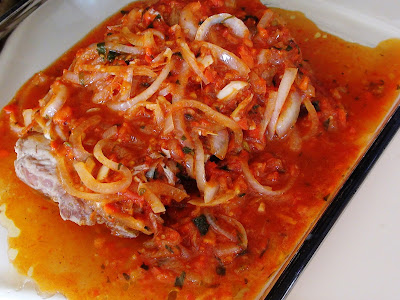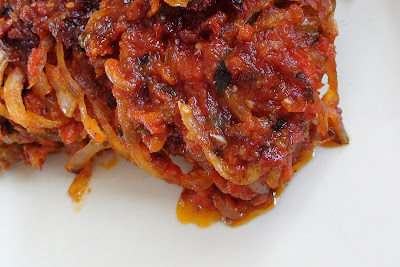Following the various layered
potato dishes, in particular, the inclusion of cheese, this being my own concoction,
but in fact is a fusion of French and Hungarian sentiments. I mention this
because to a Hungarian, there are two cuisines that matter, Hungarian and
French. Both of my Hungarian cookbooks
contain French dishes, and in the somewhat more recent publication, each chapter is divided into two sections, one for Hungarian and one for French dishes. England, the New World or the rest had no impact on Hungarian cuisine before the Internet, even though many of the ingredients, corn, tomato and
potato came from the Americas.
CHEESY HAM POTATO BAKE
3 large waxy potatoes*
salt to taste
1 cup of small broccoli florets
small wedge of onion
1 red pepper
3 Tbsp flour
1-1/4 cup cold milk
2 Tbsp butter
1/4 tsp dry mustard
1-1/2 cup grated Havarti, or any other hard white cheese
1 cups diced ham
*Waxy potatoes have low starch
content and hold their shape after cooking. You may of course use starchy
potatoes. In that case omit precooking because they would simply fall apart.
However, raw potatoes require longer baking time and it could take up to 2-1/2
hours in the oven, by which time the the broccoli and the red pepper will become limp and
unappetizing. I would omit those and just double the ham.
- Wash all the vegetables.
- Peal and slice the potatoes thinly.
- Place in a large skillet and pour enough water on
top to cover all the potato slices.
- Bring it to a steady simmer.
- Maintaining the simmer, cook uncovered until almost
all the water is reduced.
- Set the skillet aside to cool and bring a small pot
of water to the boil.
- Meanwhile prep the other vegetables.
- Plunge the broccoli florets into the boiling water
for 1 minute.
- Remove with a slotted spoon and set them aside.
- Slice the onion, and dice the red pepper.
- Make the sauce next.
- First make slurry from the flour and the cold milk.
- Melt the butter in a clean skillet.
- Add the dry mustard and the slurry and bring it to
a simmer stirring it continuously until the sauce thickens.
- If there are lumps, force the sauce through a fine
sieve.
- Add the grated cheese. It will be fine if not all
the cheese melts at this point.
- Preheat the oven to 350F.
- Next assemble the casserole.
- Butter a standard casserole dish and arrange half
the potato slices on the bottom.
- Salt the potato slices.
- Scatter the diced ham on top.
- Arrange the onion slices, the broccoli florets and
the diced red pepper on top.
- Cover with half of the sauce.
- Place the remaining potato slices on top, salt it
to taste and cover with the remaining sauce.
- Bake in preheated oven for 45 minutes or until
lightly browns on top.
- Let the casserole sit for 10 minutes before
serving.














































